An integrative re-evaluation of the Fusarium sambucinum species complex
- PMID: 40365271
- PMCID: PMC12068374
- DOI: 10.3114/sim.2025.110.01
An integrative re-evaluation of the Fusarium sambucinum species complex
Abstract
The species-rich Fusarium sambucinum species complex (FSAMSC; Fusarium, Nectriaceae, Hypocreales) is well-known for including devastating plant pathogens and toxigenic species. However, this group of grass-loving fungi also accommodates soil saprobes, endophytes, mycoparasites and rare opportunistic pathogens of humans and other animals. Recent publications have highlighted the vast phylogenetic and biochemical diversity of the FSAMSC, although a large number of taxa in FSAMSC have not been systematically described and still lack Latin binomials. In this study we established the phylogenetic breadth of the FSAMSC using an integrative approach including morphological, multilocus phylogenetic, and coalescence analyses based on five gene regions (calmodulin, RNA polymerase II largest and second largest subunits, translation elongation factor 1-α, and β-tubulin). Results obtained support the recognition of 75 taxa in FSAMSC, including all the currently known species segregates of the Fusarium head-blight pathogen F. graminearum s. lat. Thirty novel species are formally described and illustrated, while four phylogenetic species remain undescribed. An epitype is proposed for the generic type of Fusarium, F. sambucinum, from recently collected material identified by means of morphology, phylogenetics and mating experiments, fixing the phylogenetic application of the name. Additional notes are included on the typification of Fusisporium cerealis (syn. Fusarium cerealis). Taxonomic novelties: New species: Fusarium agreste Sand.-Den., J.Z. Groenew. & Crous, Fusarium amblysporum Sand.-Den., M.M. Costa, Fusarium bananae Sand.-Den., M.M. Costa, Fusarium bellum Sand.-Den., J.Z. Groenew. & Crous, Fusarium brachypes Sand.-Den., J.Z. Groenew. & Crous, Fusarium carinatum Sand.-Den., J.Z. Groenew. & Crous, Fusarium cultriforme Sand.-Den., M.M. Costa, Fusarium cuspidatum Sand.-Den., J.Z. Groenew. & Crous, Fusarium cygneum Sand.-Den., J.Z. Groenew. & Crous, Fusarium dimorphosporum Sand.-Den., M.M. Costa, J.Z. Groenew. & Crous, Fusarium dolichosporum Sand.-Den., J.Z. Groenew. & Crous, Fusarium gladiolum Sand.-Den., J.Z. Groenew. & Crous, Fusarium hamatum Sand.-Den., M.M. Costa, J.Z. Groenew. & Crous, Fusarium leptum Sand.-Den., J.Z. Groenew. & Crous, Fusarium longicolle Sand.-Den., J.Z. Groenew. & Crous, Fusarium magnum Sand.-Den., J.Z. Groenew. & Crous, Fusarium mastigosporum Sand.-Den., M.M. Costa, J.Z. Groenew. & Crous, Fusarium minutum Sand.-Den., J.Z. Groenew. & Crous, Fusarium mucronatum Sand.-Den., J.Z. Groenew. & Crous, Fusarium parabolicum Sand.-Den., J.Z. Groenew. & Crous, Fusarium platysporum Sand.-Den., J.Z. Groenew. & Crous, Fusarium pratense Sand.-Den., J.Z. Groenew. & Crous, Fusarium procumbens Sand.-Den., J.Z. Groenew. & Crous, Fusarium pseudolongipes Sand.-Den., J.Z. Groenew. & Crous, Fusarium sagittatum Sand.-Den., J.Z. Groenew. & Crous, Fusarium seculiforme Sand.-Den., J.Z. Groenew. & Crous, Fusarium subcylindroides Sand.-Den., J.Z. Groenew. & Crous, Fusarium symmetricum Sand.-Den., J.Z. Groenew. & Crous, Fusarium tropicale Sand.-Den., M.M. Costa, J.Z. Groenew. & Crous, Fusarium vermicularioides Sand.-Den., J.Z. Groenew. & Crous. Epitype: Fusarium sambucinum Fuckel. Citation: Sandoval-Denis M, Costa MM, Broders K, Becker Y, Maier W, Yurkov A, Kermode A, Buddie AG, Ryan MJ, Schumacher RK, Groenewald JZ, Crous PW (2024). An integrative re-evaluation of the Fusarium sambucinum species complex. Studies in Mycology 110: 1-110 doi: 10.3114/sim.2025.110.01.
Keywords: Coalescence; fungi; novel species; pathogens; phylogenetics; systematics; taxonomy.
© 2025 Westerdijk Fungal Biodiversity Institute.
Figures



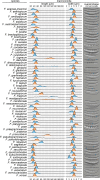
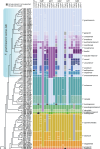






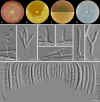







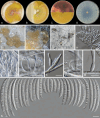
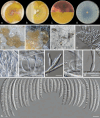
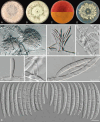








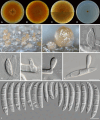



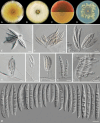












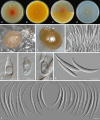



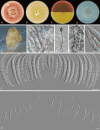






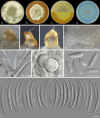





















Similar articles
-
Known from trees and the tropics: new insights into the Fusarium lateritium species complex.Stud Mycol. 2024 Dec;109:403-450. doi: 10.3114/sim.2024.109.06. Epub 2024 Sep 26. Stud Mycol. 2024. PMID: 39717659 Free PMC article.
-
Fusarium: more than a node or a foot-shaped basal cell.Stud Mycol. 2021 Aug 17;98:100116. doi: 10.1016/j.simyco.2021.100116. eCollection 2021 Apr. Stud Mycol. 2021. PMID: 34466168 Free PMC article.
-
Redisposition of acremonium-like fungi in Hypocreales.Stud Mycol. 2023 Jun;105:23-203. doi: 10.3114/sim.2023.105.02. Epub 2023 Jun 2. Stud Mycol. 2023. PMID: 38895703 Free PMC article.
-
Towards an integrated phylogenetic classification of the Tremellomycetes.Stud Mycol. 2015 Jun;81:85-147. doi: 10.1016/j.simyco.2015.12.001. Epub 2016 Jan 8. Stud Mycol. 2015. PMID: 26955199 Free PMC article.
-
Revising Clonostachys and allied genera in Bionectriaceae.Stud Mycol. 2023 Jun;105:205-266. doi: 10.3114/sim.2023.105.03. Epub 2023 Jun 12. Stud Mycol. 2023. PMID: 38895704 Free PMC article.
Cited by
-
Phylogenomic, Morphological, and Phylogenetic Evidence Reveals Five New Species and Two New Host Records of Nectriaceae (Hypocreales) from China.Biology (Basel). 2025 Jul 17;14(7):871. doi: 10.3390/biology14070871. Biology (Basel). 2025. PMID: 40723428 Free PMC article.
-
A Comprehensive Review of Hypotheses About the Biological Function of Zearalenone, and a New Hypothesis for the Function of Resorcylic and Dihydroxyphenylacetic Macrolactones in Fungi.Toxins (Basel). 2025 May 3;17(5):226. doi: 10.3390/toxins17050226. Toxins (Basel). 2025. PMID: 40423309 Free PMC article. Review.
References
-
- Akinsanmi OA, Chakraborty S, Backhouse D, et al. (2007). Passage through alternative hosts changes the fitness of Fusarium graminearum and Fusarium pseudograminearum. Environmental Microbiology 9: 512–520. - PubMed
-
- Al-Hatmi A. (2016). Phylogeny, diagnostics and antifungal susceptibility of clinically relevant Fusarium species. Ph.D. dissertation. Faculty of Science, Mathematics and Computer Science, University of Amsterdam, The Netherlands.
-
- Aoki T, O’Donnell K. (1998). Fusarium kyushuense sp. nov. from Japan. Mycoscience 39: 1–6.
-
- Aoki T, O’Donnell K. (1999a). Morphological and molecular characterization of Fusarium pseudograminearum sp. nov., formerly recognized as the Group 1 population of F. graminearum. Mycologia 91: 597–609.
-
- Aoki T, O’Donnell K. (1999b). Morphological characterization of Gibberella coronicola sp. nov., obtained through mating experiments of Fusarium pseudograminearum. Mycoscience 40: 443–453.
LinkOut - more resources
Full Text Sources
Research Materials
Miscellaneous
